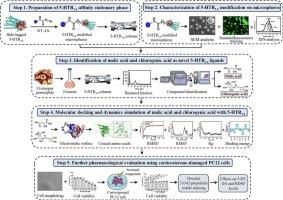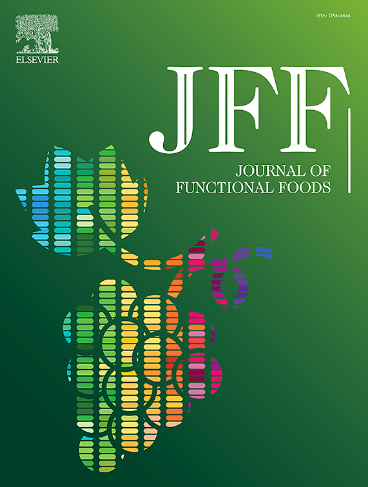Neuroactive phytochemicals from hawthorn: Preliminary evidence for malic acid and chlorogenic acid as 5-HTR1A ligands with antidepressant potential
IF 4
2区 农林科学
Q2 FOOD SCIENCE & TECHNOLOGY
引用次数: 0
Abstract
Serotonin receptor subtype 1 A (5-HTR1A) is a critical therapeutic target for neuropsychiatric disorders. Crataegus pinnatifida Bge. (hawthorn) exhibits potent antidepressant-like effects via 5-HTR1A activation, yet its bioactive constituents remain unidentified. Herein, we engineered 5-HTR1A-haloalkane dehalogenase fusion protein and immobilized it on 6-bromohexanoic acid-functionalized microspheres to establish affinity-based screening platform. Bioactivity-guided isolation identified malic acid and chlorogenic acid as 5-HTR1A ligands, and their binding energies were − 12.9 kcal/mol and − 44.7 kcal/mol, respectively. In vitro assays demonstrated that chlorogenic acid significantly protected PC12 cells from corticosterone-induced damage at concentrations as low as 2.5 μM (p = 0.0305), whereas malic acid exhibited comparable effects at 20 μM. Both compounds effectively counteracted corticosterone-induced reductions in serotonin, dopamine, and BDNF levels likely through interactions with 5-HTR1A. Collectively, these findings suggest that malic acid and chlorogenic acid are stable, high-affinity 5-HTR1A ligands with significant neuroprotective potential, making them promising lead compounds for developing novel 5-HTR1A-targeted therapeutics.

山楂中的神经活性植物化学物质:苹果酸和绿原酸作为具有抗抑郁潜力的5-HTR1A配体的初步证据
5-羟色胺受体亚型1a (5-HTR1A)是神经精神疾病的重要治疗靶点。山楂;(山楂)通过5-HTR1A激活显示出有效的抗抑郁样作用,但其生物活性成分仍未确定。本实验设计了5- htr1a -卤代烷烃脱卤酶融合蛋白,并将其固定在6-溴己酸功能化微球上,建立了基于亲和的筛选平台。生物活性引导分离鉴定出苹果酸和绿原酸为5-HTR1A配体,其结合能分别为- 12.9 kcal/mol和- 44.7 kcal/mol。体外实验表明,绿原酸在2.5 μM浓度下(p = 0.0305)显著保护PC12细胞免受皮质酮诱导的损伤,而苹果酸在20 μM浓度下也有类似的效果。这两种化合物可能通过与5-HTR1A相互作用,有效地抵消了皮质酮诱导的血清素、多巴胺和BDNF水平的降低。总的来说,这些发现表明苹果酸和绿原酸是稳定的、高亲和力的5-HTR1A配体,具有显著的神经保护潜力,使它们成为开发新型5-HTR1A靶向治疗的有希望的先导化合物。
本文章由计算机程序翻译,如有差异,请以英文原文为准。
求助全文
约1分钟内获得全文
求助全文
来源期刊

Journal of Functional Foods
FOOD SCIENCE & TECHNOLOGY-
CiteScore
9.60
自引率
1.80%
发文量
428
审稿时长
76 days
期刊介绍:
Journal of Functional Foods continues with the same aims and scope, editorial team, submission system and rigorous peer review. We give authors the possibility to publish their top-quality papers in a well-established leading journal in the food and nutrition fields. The Journal will keep its rigorous criteria to screen high impact research addressing relevant scientific topics and performed by sound methodologies.
The Journal of Functional Foods aims to bring together the results of fundamental and applied research into healthy foods and biologically active food ingredients.
The Journal is centered in the specific area at the boundaries among food technology, nutrition and health welcoming papers having a good interdisciplinary approach. The Journal will cover the fields of plant bioactives; dietary fibre, probiotics; functional lipids; bioactive peptides; vitamins, minerals and botanicals and other dietary supplements. Nutritional and technological aspects related to the development of functional foods and beverages are of core interest to the journal. Experimental works dealing with food digestion, bioavailability of food bioactives and on the mechanisms by which foods and their components are able to modulate physiological parameters connected with disease prevention are of particular interest as well as those dealing with personalized nutrition and nutritional needs in pathological subjects.
 求助内容:
求助内容: 应助结果提醒方式:
应助结果提醒方式:


